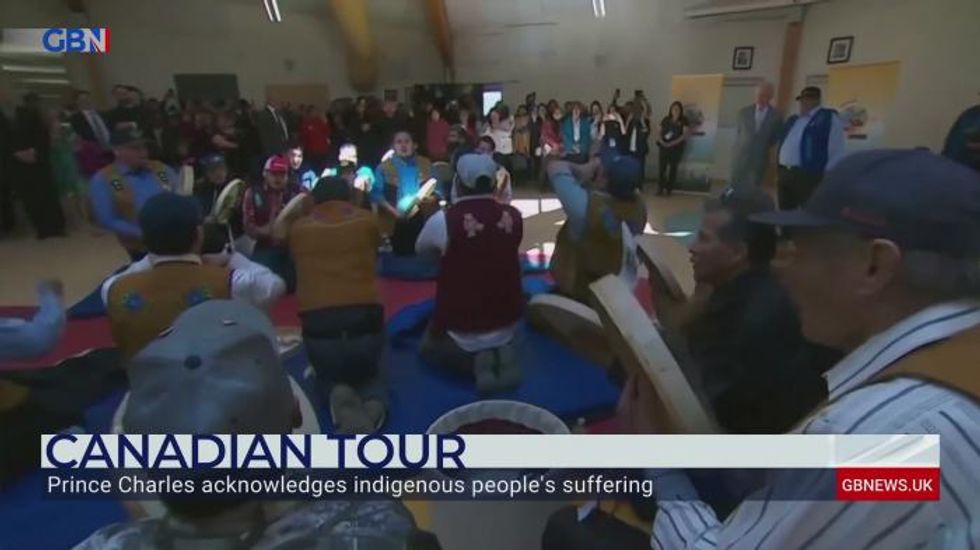Prince Charles 'acknowledges' suffering of Canada's indigenous communities on royal tour

The Prince of Wales and the Duchess of Cornwall spent their final day in Canada with indigenous communities in the Northwest Territories
Don't Miss
Most Read
Latest
There have been calls for the Queen to apologise for the “assimilation and genocide” of children discovered in mass graves who were lost in the country’s residential school children in the 19th and 20th centuries.
Indigenous leaders asked Prince Charles to do so on the Queen’s behalf during a Governor General reception in Ottawa on Wednesday, but instead he “acknowledged” their suffering.
The cost of living crisis has perhaps disproportionately affected indigenous people living in remote communities.
Chief Edward Sangris, Dettah Chief for the Yellowknives Dene First Nation, met Charles on Thursday.
Charles and Camilla
POOL
Charles and Camilla on tour
CARLOS OSORIO
He told GB News: “The cost of living is really astronomical in the north. The north is a remote community where everything costs more because of transportation. It has to be trucked up, it has to be flown up."
Dettah, with a population of around 220 people, used to be a much more isolated community until 1967 when the Queen’s visit to the area prompted the construction of a connecting road between Dettah and Yellowknife.
Charles met climate experts and visited the Dettah Ice Road – a 6.4km passage across the Great Slave Lake, connecting Dettah and Yellowknife in the winter.
It has been described as a lifeline to the remote community and has to be rebuilt each year.
Global warming means the number of days the road is usable each year has fallen, and the only other route is by air.
Charles discussed climate change
CARLOS OSORIO
The Prince of Wales discussed the “value of indigenous-led environmental approaches” with a local Professor and Permafrost Scientist.
On Wednesday in Ottawa, he urged Canadian business leaders and politicians to adopt a “war-like footing” to tackle climate change.
In the spirit of that theme, he visited the Canadian Rangers who are marking their 75th anniversary this year.
Part of the Canadian Armed Forces, they sometimes act as a search and rescue service for the surrounding remote communities and assist with forest fires and flooding relief.
Canada is experiencing the impact of climate change and parts of the Northwestern Territories have faced heavy flooding for a second year in a row.
Professor Heidi Swanson, a Canadian scientist who researches the impact of climate change on aquatic life, told GB News: “I think a lot of people, especially globally, don’t realise how remote and how isolated a lot of these communities are in Canada and how vulnerable they are to flooding.”
Camilla used the day to champion some of the causes close to her heart.
The Duchess of Cornwall visited a local school, which only has 34 students, and took part in a Wıìlıìdeh language lesson.
She learned about the history of the language and was invited to learn some key words and phrases with the class.
Camilla also visited a “transitional safe housing centre” for women who are fleeing domestic violence.
For years, the Duchess has highlighted the work of domestic abuse charities, both in Britain and abroad, and the work they do to support victims and survivors.
Her Royal Highness aims to break the taboo around the subject and has recently become Patron of the UK charity, SafeLives.
The royal couple reunited in the afternoon at the ‘Prince of Wales Northern Heritage Centre’.
Charles met local food producers to discuss environmental challenges, and how small business owners coped during the Covid-19 pandemic.
To continue Canada’s celebration of the Queen’s 70 years of service to the country, Charles and Camilla unveiled a plaque at the Northwestern Territories’ Platinum Jubilee Garden, before flying back to London.
On Thursday June 2, the Prince of Wales and the Duchess of Cornwall are expected to appear on the Buckingham Palace balcony alongside the Queen and other working members of the Royal Family for the annual flypast at the end of Trooping the Colour.














